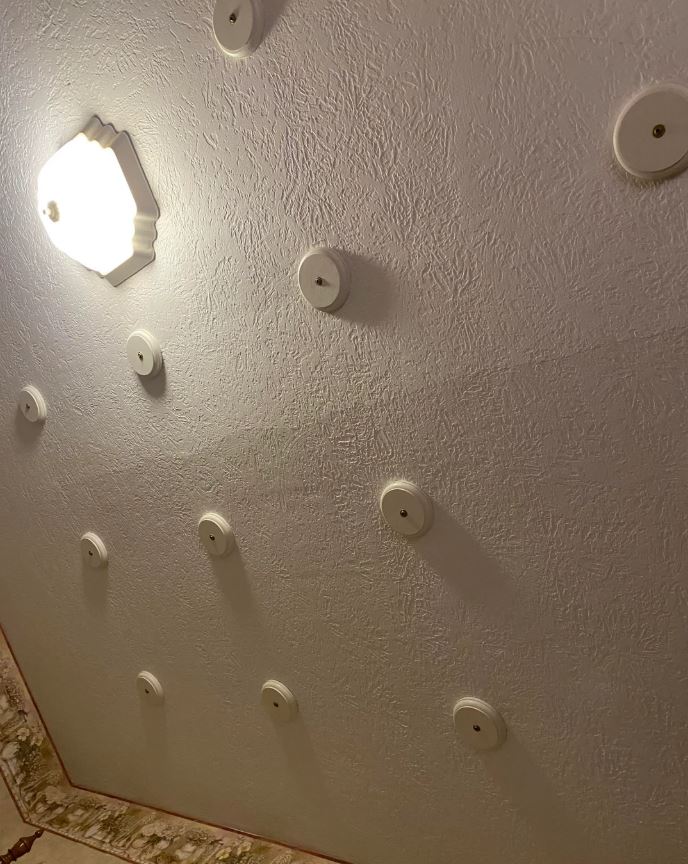I was sprawled out on the bed of a dimly lit hotel room, worn out from travel, too tired to sleep and too restless to nap, when something odd caught my eye. Dozens of tiny wooden circles were arranged in a grid across the ceiling. At first, they looked like someone had half-finished installing a bizarre art installation or maybe abandoned a lighting project.

My brain offered wild guesses—was it some sort of vintage audio system? The aftermath of a chandelier massacre? But deep down, I had a nagging feeling I’d seen this setup before. If you’ve ever stayed in an old hotel or lived in a vintage home, chances are you’ve spotted these mysterious wood disks yourself and wondered the same thing: what on earth are they for? Well, let me take you back in time. Before modern drywall became the standard, people built walls and ceilings using lath and plaster. Thin wooden slats, called lath, were nailed to the framing, and then wet plaster was applied over them. As the plaster dried, it would seep into the gaps between the slats and harden, essentially locking itself in place. It worked well enough—clean, elegant, and solid—but maintaining it over the decades? Not so easy. Fast-forward nearly a century, and plaster ceilings start to show their age.
They dry out, develop cracks, and worst of all, begin to detach from the wooden slats underneath. Gravity does what gravity does best, and eventually, parts of the plaster sag. If you’re lucky, they just droop like a tired hammock. If not, pieces can fall and cause serious damage—trust me, I once lost a lamp to one of these free-falling chunks. You can’t just screw plaster back into place. It’s brittle and will crumble under pressure. That’s where the wooden discs come in. By screwing into a small round piece of wood, usually about the size of a silver dollar, and then anchoring that into the lath behind the plaster, you create a wide surface area that distributes pressure more evenly. Instead of shattering the plaster, the disc gently pulls it back toward the ceiling. It’s like giving your ceiling a bear hug. While some prefer to use fancy metal plaster washers, wooden discs are a cheaper, simpler solution that still works like a charm
. Years ago, I lived in an old 1920s bungalow with a dining room ceiling that looked ready to collapse. I wasn’t about to rip everything out, so I decided to try the wooden disc method. I drilled pilot holes, attached the discs in a neat checkerboard pattern, gently nudged the plaster back in place, and then painted over everything. The result? It held beautifully and still looked great years later. It might not be high-tech or glamorous, but it was solid—and it worked.
If you’re only seeing these discs in one part of a building, like I did in that hotel, it probably means that specific room had a sagging ceiling problem. Maybe water damage from upstairs plumbing caused it, or maybe it was the only room anyone cared to fix. Either way, it’s a clue that the building has some age and a history behind its walls. You might be wondering whether to cover them up or leave them visible. That’s a personal choice. Some people embrace the quirky, functional look, especially in basements or workshops. Others smooth over them with joint compound and repaint, hiding them completely. But I’ve grown fond of the sight. Seeing those little discs is like reading a footnote in a home’s story—it says, “Someone tried to preserve this place.” In a world where we often toss things aside at the first sign of wear, there’s something admirable about patching things up with a bit of creativity and elbow grease. So the next time you notice wooden discs on a ceiling, don’t freak out. They’re not cameras or a strange design trend. They’re simply a humble, old-school fix for sagging plaster—a nod to the past, to resourcefulness, and to the quiet stories that linger above our heads.





